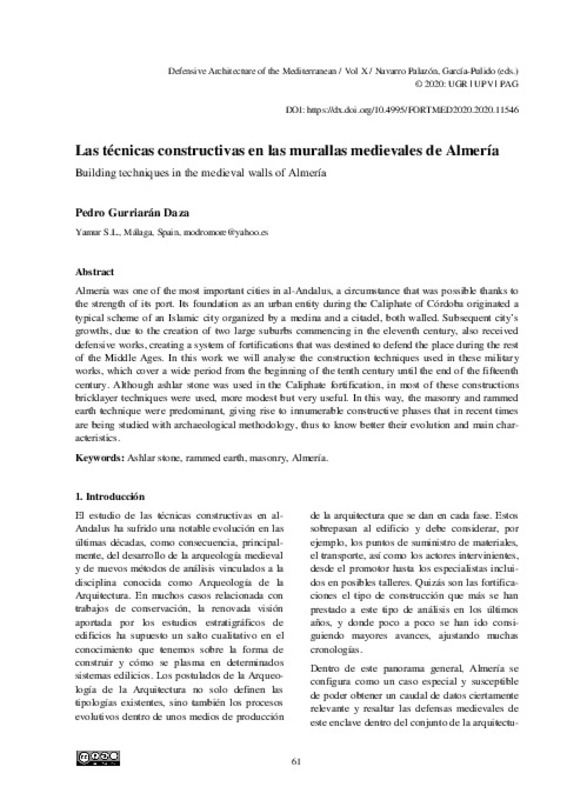JavaScript is disabled for your browser. Some features of this site may not work without it.
Buscar en RiuNet
Listar
Mi cuenta
Estadísticas
Ayuda RiuNet
Admin. UPV
Las técnicas constructivas en las murallas medievales de Almería
Mostrar el registro sencillo del ítem
Ficheros en el ítem
| dc.contributor.author | Gurriarán Daza, Pedro
|
es_ES |
| dc.coverage.spatial | east=-2.4714005; north=36.8409448; name=Parque Ramon Castilla, 2, 04002 Almería, Espanya | es_ES |
| dc.date.accessioned | 2020-07-03T09:57:50Z | |
| dc.date.available | 2020-07-03T09:57:50Z | |
| dc.date.issued | 2020-05-15 | |
| dc.identifier.isbn | 9788490488560 | |
| dc.identifier.uri | http://hdl.handle.net/10251/147366 | |
| dc.description.abstract | [EN] Almería was one of the most important cities in al-Andalus, a circumstance that was possible thanks to the strength of its port. Its foundation as an urban entity during the Caliphate of Córdoba originated a typical scheme of an Islamic city organized by a medina and a citadel, both walled. Subsequent city’s growths, due to the creation of two large suburbs commencing in the eleventh century, also received defensive works, creating a system of fortifications that was destined to defend the place during the rest of the Middle Ages. In this work we will analyse the construction techniques used in these military works, which cover a wide period from the beginning of the tenth century until the end of the fifteenth century. Although ashlar stone was used in the Caliphate fortification, in most of these constructions bricklayer techniques were used, more modest but very useful. In this way, the masonry and rammed earth technique were predominant, giving rise to innumerable constructive phases that in recent times are being studied with archaeological methodology, thus to know better their evolution and main characteristics. | es_ES |
| dc.description.sponsorship | Este trabajo se ha realizado dentro del marco del Proyecto de I+D del Subprograma Estatal de Generación del Conocimiento: “Las murallas medievales de Almería. Análisis cronotipológico y datación científica” (HAR2015-71609-P), cuyo IP es el Dr. Antonio Orihuela Uzal. | es_ES |
| dc.language | Español | es_ES |
| dc.publisher | Editorial Universitat Politècnica de València | es_ES |
| dc.rights | Reconocimiento - No comercial - Sin obra derivada (by-nc-nd) | es_ES |
| dc.subject | Fortifications | es_ES |
| dc.subject | Mediterranean | es_ES |
| dc.subject | Modern age | es_ES |
| dc.subject | Built Heritage | es_ES |
| dc.subject | Ashlar stone | es_ES |
| dc.subject | Rammed Earth | es_ES |
| dc.subject | Masonry | es_ES |
| dc.subject | Almería | es_ES |
| dc.title | Las técnicas constructivas en las murallas medievales de Almería | es_ES |
| dc.title.alternative | Building techniques in the medieval walls of Almería | es_ES |
| dc.type | Capítulo de libro | es_ES |
| dc.type | Comunicación en congreso | es_ES |
| dc.identifier.doi | 10.4995/FORTMED2020.2020.11546 | |
| dc.relation.projectID | info:eu-repo/grantAgreement/MINECO//HAR2015-71609-P/ES/LAS MURALLAS MEDIEVALES DE ALMERIA. ANALISIS/ | es_ES |
| dc.rights.accessRights | Abierto | es_ES |
| dc.description.bibliographicCitation | Gurriarán Daza, P. (2020). Las técnicas constructivas en las murallas medievales de Almería. Editorial Universitat Politècnica de València. 61-70. https://doi.org/10.4995/FORTMED2020.2020.11546 | es_ES |
| dc.description.accrualMethod | OCS | es_ES |
| dc.relation.conferencename | FORTMED2020 - Defensive Architecture of the Mediterranean | es_ES |
| dc.relation.conferencedate | Octubre 01-03,2020 | es_ES |
| dc.relation.conferenceplace | Granada, Spain | es_ES |
| dc.relation.publisherversion | http://ocs.editorial.upv.es/index.php/FORTMED/FORTMED2020/paper/view/11546 | es_ES |
| dc.description.upvformatpinicio | 61 | es_ES |
| dc.description.upvformatpfin | 70 | es_ES |
| dc.type.version | info:eu-repo/semantics/publishedVersion | es_ES |
| dc.relation.pasarela | OCS\11546 | es_ES |
| dc.contributor.funder | Ministerio de Economía y Competitividad | es_ES |








